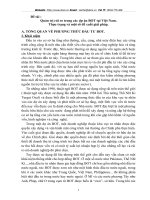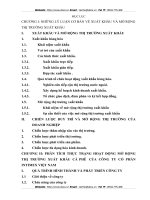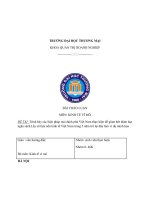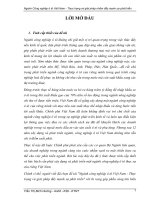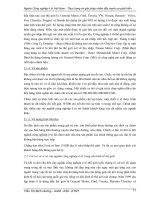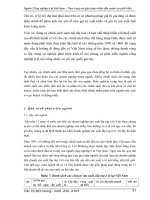Quản trị nguồn nhân lực trường đại học địa phương ở miền Trung Việt Nam -Thực trạng và Giải pháp [full]
Bạn đang xem bản rút gọn của tài liệu. Xem và tải ngay bản đầy đủ của tài liệu tại đây (1.76 MB, 123 trang )
MANAGEMENT OF HUMAN RESOURCE AT THE
LOCAL UNIVERSITIES OF CENTRAL REGION
OF VIET NAM: REALITY AND SOLUTIONS
A Dissertation Presented to
the Faculty of the Graduate School
Southern Luzon State University, Lucban, Quezon, Philippines
in Collaboration with Thai Nguyen University
Socialist Republic of Vietnam
In Partial Fulfillment of the
Requirements for the Degree
Doctor of Philosophy in Education Management
CHAU VAN LUONG - (MONEY)
March 2014
ii
APPROVAL SHEET
In partial fulfillment of the requirements for the degree Doctor of philosophy in
Educational Management, this research entitled “Management of Human Resources at
the local Universities of central region of Vietnam: reality and solutions” has been
submitted by Chau Van Lng - Money, and is hereby recommended for oral examination.
DR. LEONISA O.BERNARDO
Research Adviser
Approved by the Oral Examination Committee, in partial fulfillment of the
requirements for the degree Doctor of Philosophy in Educational Management offered by
Southern Luzon State University, Republic of the Philippines in collaboration with Thai
Nguyen University, Socialist Republic of Vietnam.
DR. ……………………
Member
DR………………………….
Member
DR…………………………
Member
DR. ………………………
Member
DR. ………………………… SUSANA A. SALVACION, Ph.D.
Chairman Dean, Graduate School
Accepted in partial fulfillment of the requirements for the degree Doctor of
Philosophy in Educational Management offered by Southern Luzon State University,
Republic of the Philippines in collaboration with Thai Nguyen University, Socialist
Republic of Vietnam.
WALBERTO A. MACARAAN, Ed .D
Vice President, Academic Affairs
Date___________________
iii
ACKNOWLEDGEMENT
I would like to express my sincere thanks to Republic of the Philippines Southern
Luzon State Universityb Lucban, Quezon and teachers, Tutors for the invaluable support
during the course of the study and particularly for guidance in preparation of this thesis:
Dr. Cecilia N. Gascon, President of the Southern Luzon State University, Republic
of the Philippines;
Dr. Dang Kim Vui, President of Thai Nguyen University;
Prof. Nordelina (Nordy) B. Ilano, Director, Office of International and Alumni
Affairs (OIAA) Southern Luzon State University (SLSU) Lucban, Quezon, Philippines;
I special thanks also Dr. Leonisa O. Bernardo for her supervision, enthusiastic
support, invaluable guidance, suggestions and comments during preparation and
completion of this research;
Dr. Tran Thanh Van, head of postgraduate, Thai Nguyen University and Prof. Dr
Hùng, director of International training center.
I express gratitude would be given to the International Relations Center of
Agriculture and Forestry University, which created the opportunity for me to undertake the
PhD’s course on Educational Management and expand my knowledge in various aspects
of educational management.
My thanks also express to leaders, oficcers, teachers and administrational staffs of
local Universities which include Hong Duc University, Ha Tinh University, Quang
Binh University, Quang Nam University, Phu Yen University and Pham Van Dong
University which co-operate and support me during the study time and universities’
Reality survey time.
Last but not least, the special thanks are given to my lovely family with my deceased
day, my mom my wife and my children, who strongly support and encourage author to
complete the course.
Thank you,
Chau Van Luong – (Money)
iv
TABLE OF CONTENTS
Page
TITLE PAGE i
APPROVAL SHEET ii
ACKNOWLEDGEMENT iii
TABLE OF CONTENTS iv
LIST OF TABLES vi
LIST OF FIGURES vii
LIST OF APPENDICES viii
ABSTRACT x
Chapter I: INTRODUCTION 1
Background of the study 2
Objectives of the study: 4
Research hypothesis 5
Significance of the study 5
Scope and limitations of the study: 5
Definitions of terms: 6
Chapter II: REVIEW OF LITERATURE AND STUDIES 9
Conceptual Framework 9
Research Paradigm 34
Chapter III: METHODOLOGY 35
Localities of the study: 35
Research Design 35
Population and Sampling 35
Research Instrumentation 36
Data gathering procedures 36
Statistical Treatment 38
Chapter IV: RESULTS AND DISSCUSSION 42
Chapter V: SUMMARY, CONCLUSIONS AND RECOMMENDATIONS
Summary: 52
Findings: 52
Conclusions 53
Recommendations: 53
BIBLIOGRAPHY 56
APPENDICES 59
CURRICULUM VITAE 128
v
LIST OF TABLES
Table Page
1. Team managers, lecturer and staff year 2008-2012 28
2. Admissions year 2013 29
3. List the Local Universities of central region of Viet Nam 35
4. Frequency, Percentage and Distribution of the Respondents 36
5. General statistics on the objects of survey participants: Gender, Position,
Qualifications, Working time 40
6. Mean Deviation of variants Reality 43
7. Mean Deviation of variants necessity 44
8. Mean Deviation of variants Feasible feasible 44
9. Correlations 45
10. The Reality of human resources management: Perception 48
11. The Reality of human resources management: Function of Recruitment and
selection 48
12. The Reality of human resources management: Functional of training and
development. 49
13. The Reality of human resources management: Function of retention 50
14. The need of the perfect solution HRM 51
15. The feasibility of the solutions to improve HRM 52
vi
LIST OF FIGURES
Figures Page
1. The HRM Framework 14
2. Function of HRM 17
3. Diagram organizational structure 27
4. Diagram representing independent variables and dependent variables and results of the
study 34
5. Location of Local universities in the Central Region of Vietnam 41
vii
LIST OF APPENDICES
Appendix Page
1. Appendix "A", The Tables 59
2. Appendix "B", Question survey questions reality, the necessity and feasibility of a
complete solution HRM 114
3. Appendix "C", Established Decision 6 Local University 118
4. Appendix "D", Mechanisms, policies of HRM of the local university 119
5. Appendix "E", Confirmation of the universities surveyed 120
viii
Title:
MANAGEMENT OF HUMAN RESOURCE AT THE LOCAL
UNIVERSITIES OF CENTRAL REGION OF VIET NAM:
REALITY AND SOLUTIONS
Researcher:
CHAU VAN LUONG – (MONEY)
Degree:
Doctor of Philosophy in Educational Management
Name/Address of the
Institution:
Southern Luzon State University
Graduate School Lucban, Quezon
Date Completed:
April 2014
Adviser:
Dr. LEONISA O. BERNARDO
ix
ABSTRACT
The main purpose of this study is to analyze the management of human resources
of local universities in central Vietnam through three main functions: functions
Recruitment and Selection, functions Training and Developing, and functions retention.
Thereby offering solutions to improve the management of human resources of the local
university in Central Vietnam.
This study used the descriptive design of the correlation analysis of the variables
investigated, measuring the administrative functions of human resources limit the use of
the questionnaire and the results of operations of the local universities in recent years.
Questionnaires were used to collect data through surveys at six local universities, the three
subjects: of management staff, faculty and administrative staff of the school. Nearly 450
peoples answered in this study.
Data was analyzed by SPSS software. Thereby, there is no significant distinction of
three subjects answered the questionnaire, the unanimously proposed solutions are given.
The solution proposed management is necessary and feasible to improve the
management of human resources local university in Central Vietnam in the coming years.
1
Chapter I
INTRODUCTION
There are 14 coastal provinces in the central region of Vietnam, running from Thanh
Hoa to Binh Thuan Province
1
. The total area of this region is 90.790 km
2
, accounting for 28%
of the total natural area of the country. The central region is bordered in the North by the Red
River Delta and the Northern mountainous areas, in the South by the Southern region, in the
East by the East Sea, and in the West by the Central Highland. The Central region of Vietnam
is surrounded by ranges of mountains, running from the West to the coastal line in the East.
This region has very extreme weather conditions. However, it is very rich in natural resources.
With a coast line of around 1,000 km, it has great potential for marine economic development.
This central region has many beautiful landscapes which are well-known in the country.
Social conditions: This region has a population of 18,994,709 people, accounting for 21.7% of
the population of the country. Economic conditions: Economic growth of this central region is
still slow. Education and training: People in this region are known to be studious. There are
many cultural celebrities and heroes in the protection, and development of the country.
Tertiary education: There are two regional universities, including Hue University and Danang
University. In addition, there are several other universities under the management of the
ministries. There have also been 8 local universities formed under the management of the
provincial authorities since 1997 in the central region. This accounts for 8/22 universities in
the country
2
.
In the 21
st
century, education and training in general and tertiary education in particular
is facing many challenges of the intellectual economy, globalization, expansion of
information technology, and harsh competition of high quality human resources, Tertiary
1
There are 14 coastal provinces in the central region of Vietnam: Thanh Hoa, Nghe an, Ha Tinh, Quang Binh,
Quang Tri, Thua -Thien- Hue, Da Nang , Quang Nam, Quang Ngai, Binh Dinh, Phu Yen, Khanh Hoa, Ninh
Thuan và Binh Thuan.
2
See Table A1, Appendix "A"
2
education in Vietnam nowadays plays an important role. The Resolution N0: 14/2005/NQ-CP
confirms that
3
: "Reform of higher education is the cause of the people under the leadership of
the Party and the State's management. The State increases investment in higher education,
and to promote socialization, creating favorable conditions in policies for organizations,
individuals and the whole society to participate in the development of higher education”
4
.
During the past few years, higher education in Vitnam has been developing in terms of both
quantity and training scale. Since 1997, the education system in Vietnam has established local
universities to meet the demands of human resources for the localities alongside national
universities, regional universities and universities under the management of ministries.
In the process of formation and development, besides the advantages, local universities
are facing many challenges, especially in human resource management. To basically and
comprehensively renovate the Vietnam education in the period 2011-2020, it is necessary and
urgent to conduct a study and to propose appropriate and effective solutions HRM of local
universities since it will make a decision upon the existence and development of these
universities at the current time. Thus, I choose the topic this study “Management of Human
Resources at the local Universities of central region of Vietnam: reality and solutions”.
Background of the study
After 25 years of renovation and 10 years implementation of the 2001-2010 Education
Development Strategy, tertiary education of Vietnam has developed significantly in terms of
the scales, the varieties of universities, and the training forms. Social resources have been
mobilized more and more and have had great achievements, providing labor forces for the
socio-economic development, industrialization, modernization, and international integration.
3
[19]: Resolution On substantial and comprehensive renewal of Vietnam’s tertiary education in the 2006-2020
period of The Government No: 14/2005/NQ-CP
4
[19]: Resolution N0: 14/2005/NQ-CP, On substantial and comprehensive renewal of Vietnam’s tertiary
education in the 2006-2020 period
3
Formation of local universities is based on the demands for socio-economic
development, especially the needs for training human resources for the localities and the
region.
During the past few years, local universities in particular and higher education in
Vietnam in general have got many favourable conditions and have gained many achievements
as evaluated in the 2011-2020 Education Development Strategy.
In addition to the advantages mentioned, there are still many disadvantages and
weakness in the education of Vietnam: the national education system is not consistant; quality
of education is still very low as compared to the demands for development of the country in
this new period and the education level of the countries which have well-developed education
system in the region and in the world; The relation between growth in number and enhanced
quality has not been clarified; The professional skills of the graduates do not meet the
requirements of workplaces; there are signs of misled behaviour and lifestyle of parts of
students; there are still inadequate points in education management. Education management is
still subsidised, duplicated and fragmented; professional responsibility and authority donot go
together with the financial and human resource management responsibility and authority.
Legal system and education policies are not consistent. They are not amended and modified in
the timely manner. Policies for mobilisation and allocation of resources for education are not
relevant; resources are not used efficiently. Investment of the Government in education does
not concentrate on priority objectives; expenditure on professional activities is still low. There
are not sufficient and practical regulations on the self-reliance and social responsibilities of
education institutions; parts of teachers and education managers do not the requirements and
duties of education in the new period. Teaching staff is redundant, yet insufficient and
inconsistent in professional structure at the same time. Rate of teachers with post-graduate
degrees is still very low; the percentage of students per lecturer does not meet the set target in
the 2001-2010 Education Development Strategy. There is still a small part of teachers and
4
education managers who show their lack of responsibility and dedication to their profession.
They violate the moral values and lifestyles of teachers, which has negative impacts upon the
reputation of teachers in the society. Capacity of parts of teachers and education managers is
low. Policies for teachers and education managers, especially those related to salaries and
allowances are not adequate and do not encourage talented people to work in education. In
addition, the policies have not given a driving force for teachers and managers to strive in
their professional activities. Training and retraining of teachers do not meet the requirements
of education ronovation.
Thus, during the past ten years, education of our country has gained many
achievements, contributing significantly to improved intellectual standards of people, human
resources development, talent fostering, and security ensuring. This facilitates the country in
the world integration process. Education in Vietnam in general and especially of local
universities need to take careful, thorough and serious consideration in order to have adequate
and effective solutions Management in general and HRM.
Objectives of the study:
This study acmod to fuid out the management of human resources at the local uni at
central Vietnam with an end view of solutions HRM, complete recommendations for this
following school year. The study focused on the following objectives:
- Activity human resource management focuses on the following 3 functions:
+ Function of Recruitment and Selection
+ Functional of training and development
+ Function of retention (maintain)
- Recommendations complete Solutions to HRM from the above variables:
+ Cognitive Solutions HRM
+ Completes Group solution HRM:
++ Function of Recruitment and Selection
5
++ Functional of training and development
++ Function of retention (maintain)
To achieve this goal, we rely on the evaluation of the 3 subjects in the university:
management, Lecturer and administrative staff.
Research hypothesis
There was no significant difference the perceptions (assessment) of the 3 groups of
respondent as to the management of human resource functions.
Significance of the study
This study is aimed at proposing Solutions for human resource management at the local
universities of central region of Vietnam. Benefits of these solutions will be as follows:
This study is aimed at proposing Solutions for human resource management at local
universities in Vietnam. Benefits of these solutions will be as follows:
As for the university managers: improve capacity of management, direction, and
organization in accordance with the regulations and in a scientific and effective way.
As for Lecturer: Provide favorable conditions so as to promote teaching capacity and to
improve the quality of teaching and scientific research. Contribute to improving the quantity
as well as the quality of Lecturer.
As for administrative staff: Carry out their work in accordance with the regulations and
enhance the quality of their performance, contributing to improving quality of teaching,
learning, and conducting researches of teachers and students.
As for schools and society: Improve quality of education and provide prestige and a
brand name for the university. Society trust and have confidence in the university.
As for local policy makers: Refer these policies to develop and finalise Solutions HRM
of their schools in an appropriate and effective manner.
Scope and limitations of the study:
6
This study will propose Solutions on effective human resource management at local
universities in central Vietnam. As a baseline study, we will select 6 local universities in the
central region, including: Hong Duc, Ha Tinh, Quang Binh, Quang Nam, Pham Van Dong,
and Phu Yen universities. The number of participants in the survey will be about 450 people.
There will be 75 participants from each university, including 25 manager, 30 Lecturer, 20
administrative staff.
Research on human resource management local universities range, this thesis would
have access to the basic content related to improvement of human resources management,
namely Recruitment and Selection, training-development and retention of human resources.
The author wishes to contribute to the development of local universities in Central Vietnam.
Timing:
The thesis mainly focuses on the status of local universities in central Vietnam in the
year 2013.
Definitions of terms:
Human Resources: Human resources include all knowledge, skills, experiences,
capacity, and creativeness of human which are related to the development of each individual
and of the country.
Human Resources in Education: This indicates human resources in education. In
universities, human resources include managers, teachers and administrative staff.
Policy: is a set of policy guidelines, the incentives depends on the object in order to
achieve the policy goals of the policy holder.
Education policy and training: are the policy and measures of the Party and the state
to foster and develop the qualities and capabilities to every citizen the ideological, moral,
scientific, health and career.
Management/Governance: management is the targeted impacts of the managing
objects on the managed objects in order to achieve the best results with predetermined targets.
7
Human Resources Management: The design and implementation of policies and
activities to make the field for people to contribute the most effective value for the
organization; namely Recruitment and Selection, training and development, and retention;
including areas such as human resource planning, analysis and design work, recruiting and
selection, performance evaluation, training and development, compensation, health and safety
personnel, and labor relation,
Local Universities: are public universities which provide multi-level and multi-sectoral
trainings; these universities are under the management of the provincial people’s committees
and under the state and professional management of the Ministry of Education and Training.
A manager is a person who is responsible for allocating manpower and other resources
and directing the operation of one part or the whole of an institution so that the institution
operates effectively and achieves its objectives. According to “management level”, managers
include top level and intermediate managers.
Intermediate managers: Intermediate managers are people who receive large scale and
comprehensive policies and strategies from top (senior) managers and turn them into specific
and separate objectives and plans for their staff to implement.
Top/senior managers: Top managers are people who are responsible for giving
instructions and directions for operation of the whole organization. Top managers need to
prepare and identify objectives, policies and strategies for their institutions. The objectives set
by top managers in the hierarchical order in the institution need to be transferred to each
member. Top managers usually represent the organization in community activities such as
trading and negotiation. They spend time to discuss with other senior managers in the
organization or with other related people in other organizations.
8
In public universities
5
, top managers are chairpersons of the university board, rectors
and vice-rectors; Intermediate managers are heads and deputy-heads of the departments.;
other people do not keep management positions such as lecturers, administration staff.
5
[13]: See Decision issuing "university charter" of prime minister no. 58/2010/QD-TTg
9
Chapter II
REVIEW OF LITERATURE AND STUDIES
This Chapter presents the theoretical background on human resources management
(HRM) in general and at local universities in particular and other related issues. In addition,
some diagrams and definitions of related concepts will be given to help readers have a better
understanding of the concerned issues.
Management /Governance:
According to Gallagher (2002:2), “governance is the framework of relationships
which bring about the aggregation, policy entrustment, planning and decision making, taking
responsibility to the university, community, and learners for the confidence, compatibility
and effectiveness of management fee; planning of policies and making decision on big
investments.”
On the other hand,
- According to Mary Parker Follett: Management is the art of achieving goals
through others.
- Koontz and O 'Donnel: Management through its tasks means that "designing and
maintaining an environment in which individuals work together in groups in order to
complete the defined mission and goals.”
- James Stoner and Stephen Robbin: Management is the process of planning,
organizing, leading and controlling the activities of the members of the organization and
using all the resources of the organization in order to achieve the goals proposed.
Thus, we can understand that management is the targeted impacts of the managing
objects on the managed objects in order to achieve the best results with predetermined
targets.
- Hoe (2012) defines manager as a person who is responsible for the fulfilling of the
goals and objectives of the organisation while taking the role of managing the employees in
10
the organisation. Manager is also supported by the followers who will report and help the
managers with relevant task (Huselid, 1995).
- Dessler (2009) states that manager confronts the managing function through 4
perspectives namely planning, organizing, leading, and controlling. It is also determined as
the managing process that is often conducted and carried by the managers of the
organisation.
Currently for public universities in Vietnam, the concept of governance (governance)
can be understood as management (management).
Manpower/Human resources:
Depending upon the context, the concept manpower is sometimes used in place of
human resources or workforce of an institution.
Manpower means specific persons who undertake a position or a place in an office or
institution. The concept human resource is often used to describe people (members) who are
working in an institution.
Manpower resources/Human resources (HR):
According to the United Nations: “Human resources include all knowledge, skills,
experiences, capacity, and creativeness of human which are related to the development of
each individual and of the country.”
According to the World Bank: ” HR are all human possessions, including physical
strength, intellectual power, professional skills, etc… of each individual”.
Staffing/HR: refers to the process of recruiting and evaluating performance of the
employees and overall subordinate performance that are based on the performance standards
set by the agreement between managers and employees / subordinates (Dessler, 2009).
According to ILO, “Human resources of a nation are all people within a range of age
who are able to work”.
11
Since the mid-1980’s Human Resource Management has gained acceptance in both
academic and commercial circles. HRM is a multidisciplinary organizational function that
draws theories and ideas from various fields such as management, psychology, sociology
and economics.
There are countless definitions of what HRM is or should be and there is not one
definition that can define what HRM exactly is.
There is no “best way” to manage people and no manager has formulated how people
can be best managed because managing people is not a straightforward thing. People are
complex beings that have complex needs. Effective HRM very much depends on the causes
and conditions that an organisational setting would provide.
Although the nature of people at work and their complexities make their management
a difficult task, it provides a unique opportunity for academic (e.g. universities) and
professional bodies to investigate HR related issues and continuously aim to develop HRM
practices and improve the way human resources are managed in organisations.
Human Resources in education:
Are the resources in education. In universities, human resources include managers,
lecturers, and administration staff.
A Managers: Is an individual who is in charge of a certain group of tasks, or a certain
subset of a Organisation. A manager often has a staff of people who report to him or her.
Lecturers and administrators staff: Healthfield (2012) defined Lecturers and
administrators staff play critical roles in transferring learning context to those who were
received the trainings. Baldwin and Ford (1988) asserted that Lecturers and learning
activities had its polar whether the positive training transfer was formed if the employees
could apply successfully the training contents into specific situations and vice versa. During
the time, there were many previous studies written about the relationship between Lecturers
and administrators staff and human resource training satisfaction in which these previous
12
studies considered human resource training satisfaction (Zumrah, 2012). Noe and Schmitt
(1986) found transfer of training was significantly related to educator performance
improvement including their fiscal management and relationships with the community.
Governance/Management of Human Resources:
Is the management of people within an institution and bringing people into an
institution to help them do the work, paying them for their work, and addressing emerging
issues. More specifically, it includes all activities of an institution to attract, deliver training,
develop, and maintain a workforce appropriate with the requirements of the institution in
terms of the quantity, quality, and structure (quantity, structure, training level, qualification
and capacity)
According to Wikipedia, the free encyclopedia: Governance of human resources
(HRM or HR) is management of workforce of an institution- human resources. It involves
attracting, recruiting, training, evaluating, and offering preferential policies to workers. In
addition, it supervises the operation, and ensures to comply with labor law.
Theo Zorlu Senyucel in Managing the Human Resource in the 21st Century
6
:
The purpose of HRM is to ensure that the employees of an organization are used in
such a way that the employer obtains the greatest possible benefit from their abilities and the
employees obtain both material and psychological rewards from their work (Graham, 1978).
“HRM is a distinctive approach to employment management which seeks to achieve
competitive advantage through the strategic deployment of a highly committed and capable
workforce, using an array of cultural, structural and personnel techniques.” Storey (1995: 5).
“HRM is a managerial perspective which argues the need to establish an integrated
series of personnel policies to support organizational strategy.” Buchanan and Huczynski
(2004: 679).
6
[39]:
Managing the Human Resource in the 21st Century
13
“HRM is a strategic approach to managing employment relations which emphasizes
that leveraging people’s capabilities is critical to achieving competitive advantage, this being
achieved through a distinctive set of integrated employment policies, programmes and
practices.” Bratton and Gold (2007: 7).
In essence, the concept of integrated HRM stated above, we can agree to understand:
"Human resource management policies are designed and implemented operational areas to
make people play most effectively contribute value to the organization, including areas such
as human resource planning, analysis and design tasks, recruiting and selection, performance
evaluation, training and development, remuneration, health and safety personnel, and labor
relation, ".
Targets of HRM:
Is laborers as individuals, staff in an institution and issues relating to them such as
work and their rights and responsibilities and those of their employers.
Objectives and significance:
The objective of HR in education is to provide schools and education and training
facilities with a pool of staff, teachers, and employees as required and to make the best use of
these staff.
Significance of HRM:
As we all know that people form the institution, make it operate, and make a decision
upon its success or failure. HR is an inevitable source of an institution. As a result, HRM is a
very important area of leaders in an institution. On the other hand, all governance activities
are done by human and via human. Therefore, activities in an institution will not be effective
if it does not have good governance of HR.
14
Figure 1: The HRM framework (adapted from Beer et al. 1984: 16)
7
Governance of HR is an integral part of social governance in general and institutional
governance in particular.
Governance of HR in an institution is actually the treatment of that institution to its
employees. In other words, governance of HR is to bring people to an institution, helping
them performing their work, making payment for their work and addressing emerging issues.
Economic returns of all activities in an institution depend on many factors, including
its people. Therefore, managers need to pay special attention to recruitment, arrangement, and
mobilisation of people in that institution.
7
[ 7]: See Zorlu Senyucel, Managing the Human Resource in the 21st Century, 2009.
Situational factors
Workforce characteristics
Business strategy and conditions
Management philosophy
Labour Conditions
Task technology
Laws and societal values
Interest of Stakeholders
Management
Shareholders
Employee groups
Government
Communities
Unions
HRM Policy Choices
Employee influence
Human resource flow
Reward and work systems
HRM Outcomes
Commitment
Competence
Congruence
Cost-effectiveness
Long-term consequences
Individual well-being
Organisational effectiveness
Societal well-being systems
15
Origins of HRM
Any management idea that is used to help managers understand the complexities of
people at work is always based on what is already known anv d what has been a success or a
failure due to certain causes and conditions in an organisational context.
Just like today’s managers, those in 3000 BC faced resource problems: how to find
skilled people for the right tasks, how to make sure people do what they should be doing, how
to keep people going when the times are tough, etc. In terms of management challenges not
much has changed. However, as our social, cultural, economic and political systems have
changed the way we work and our working conditions also changed tremendously.
Only responsibly for getting the job done but also responsible for finding the right
people for the right job, getting the job done on time, save costs, liaise with various
stakeholders, develop and retain existing staff, keep staff morale high, increase staff
productivity, etc.
In 3000 BC the most important managerial task was to finish the project at all costs; in
21st Century, however, we are trying to create a healthy balance where organisational targets
are achieved and individual needs are met as much as possible.
The roots of people management can be traced all the way back to Stonehenge, but
people management as we know it today probably stems from the Institute of Personnel
Management (IPM); established in 1946 main aim of which was to meet the increasing need
for labour and personnel specialists.
Between 1950 and 1970 the UK government passed legislations in which employment
laws were created to improve conditions at work, meet employee’s health and safety needs,
increase employees’ rights, keep employment records (start date, pay, holiday entitlement,
etc.) and introduce personnel specialist in the workplace. In 1960s, management thinkers
Maslow, Argyris and Herzberg placed greater emphasis on human resources and draw
attention to the importance of issues such as motivation, commitment, learning and
16
development. In 1970, new legislations promoting employment standards and sexual equality
at work sealed the importance of the personnel management function at work.
In the 1980s and 1990s the traditional personnel management function was under
heavy criticism both from the academic and commercial institutions. It was argued that the
traditional personnel management functions were not adequate and sophisticated enough to
cope with the uncertainties of the environment, people and changing nature of work. Thus,
Human Resource Management was born out of the debate that a more sophisticated model of
people management is needed to cope with these uncertainties, not only on the operational
level but also on the strategic level to achieve competitive advantage.
Functions of HRM
It includes the response to the changes of the environment to socio-economic and
political changes; the continuous changes of labor markets or quality of staff, changes of the
law on labor. HRM therefore can be divided into three main groups of function as follows:
Recruitment and Selection, Training and Developing and Retention of HRM.
Recruitment and Selection of HRM
These are activities which are aimed at ensuring sufficient quantity and quality of
managers and staff appropriate with the vision, mission, objectives, and values of the
institution. Activities consist of:
- Analysis and design of work: This process involves identifying, reviewing and
surveying tasks and responsibilities related to each specific work in order to develop
functions, responsibilities and technical requirements of the work. These will be the
grounds for recruiting, selecting, training and satisfactorily address remuneration of
employees.
- Selection of HR: this process involves attracting qualified and competent people and
properly putting them at different positions needed in the institution.
Funtion Training and Developing of HRM
